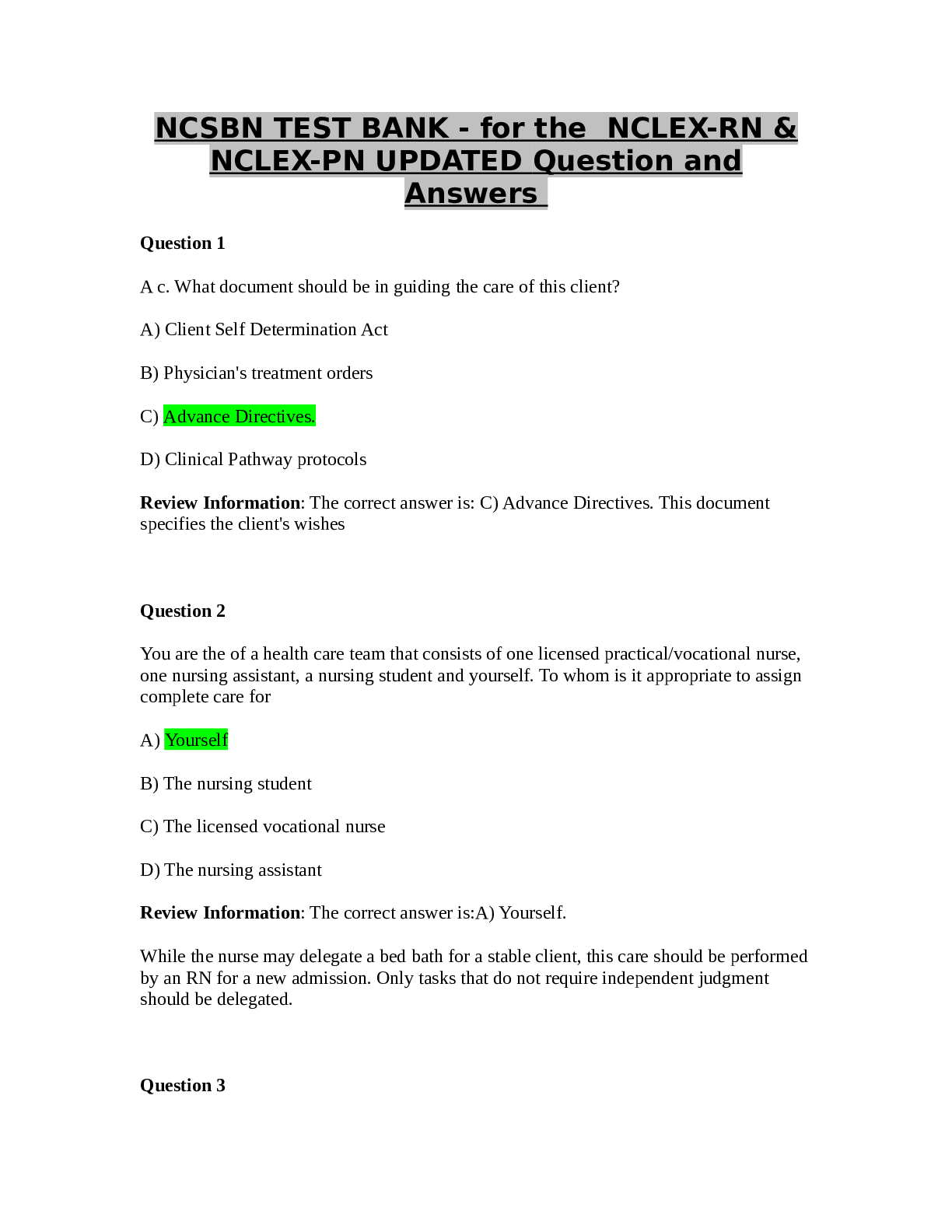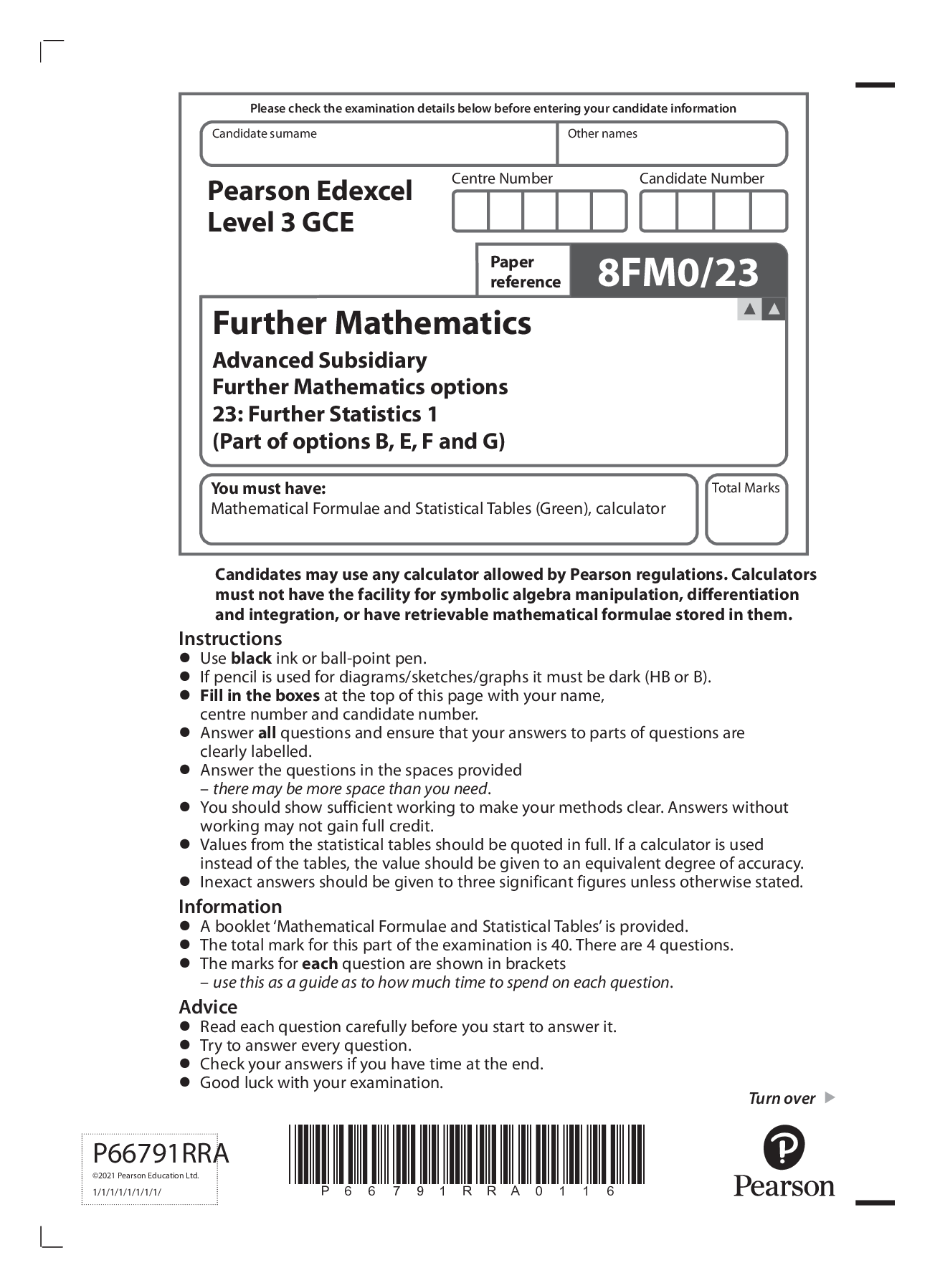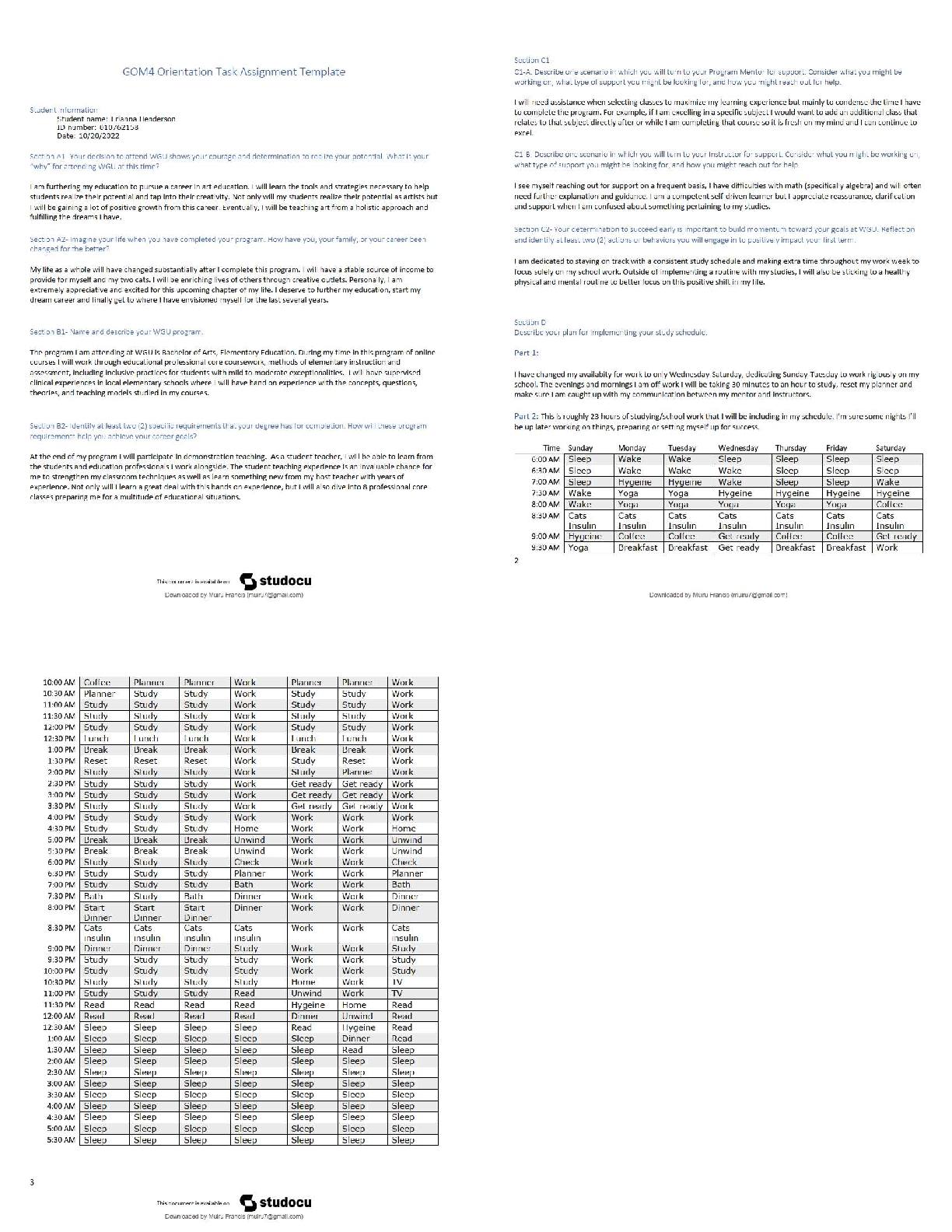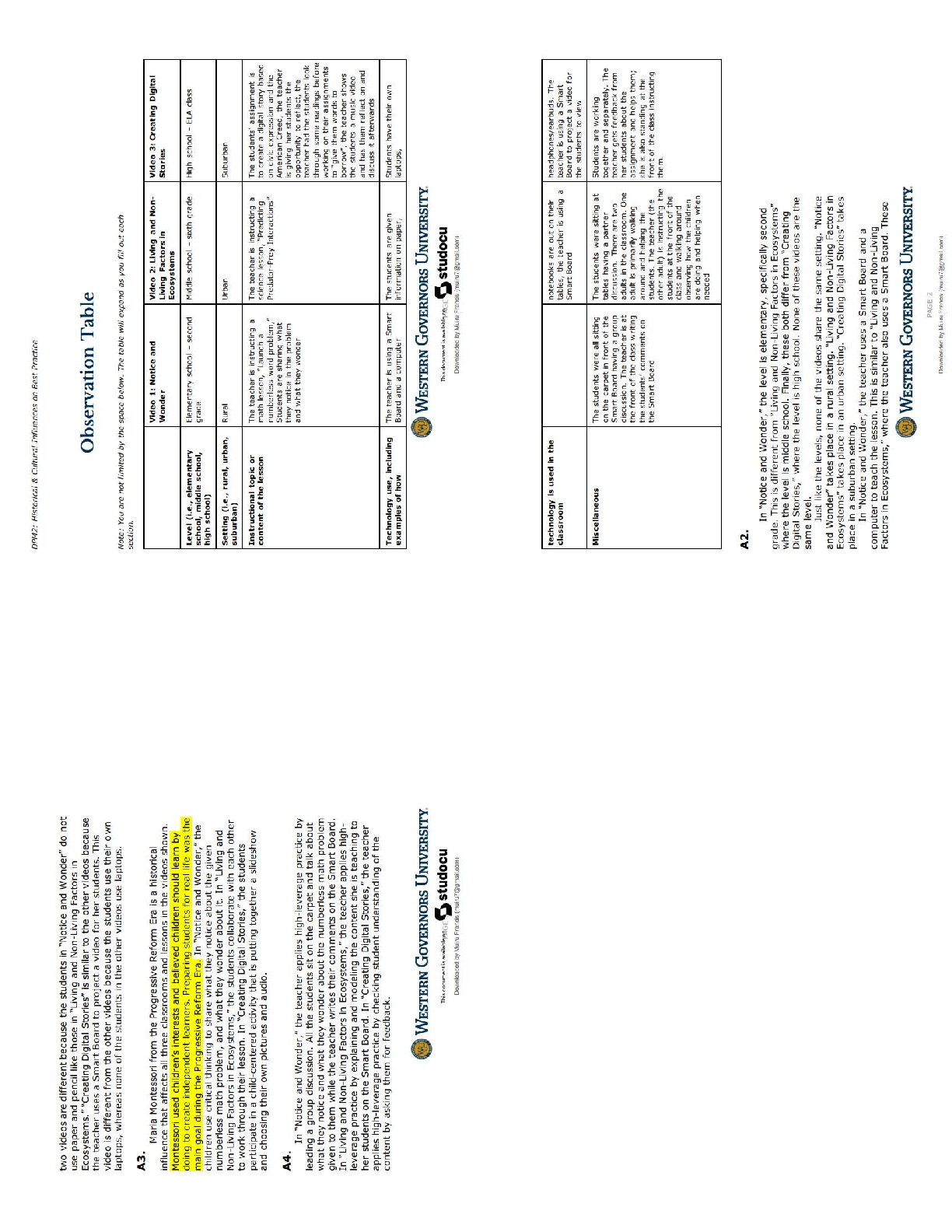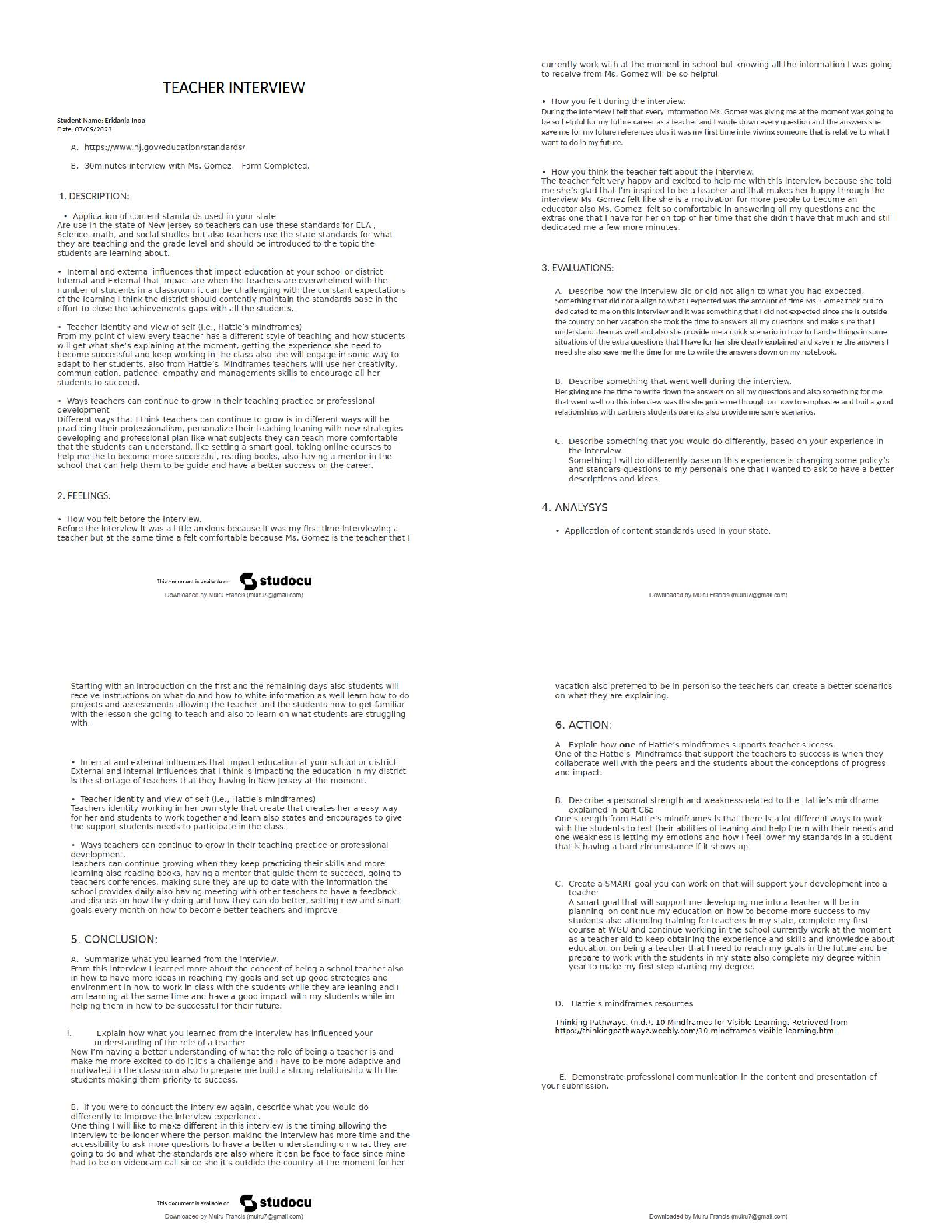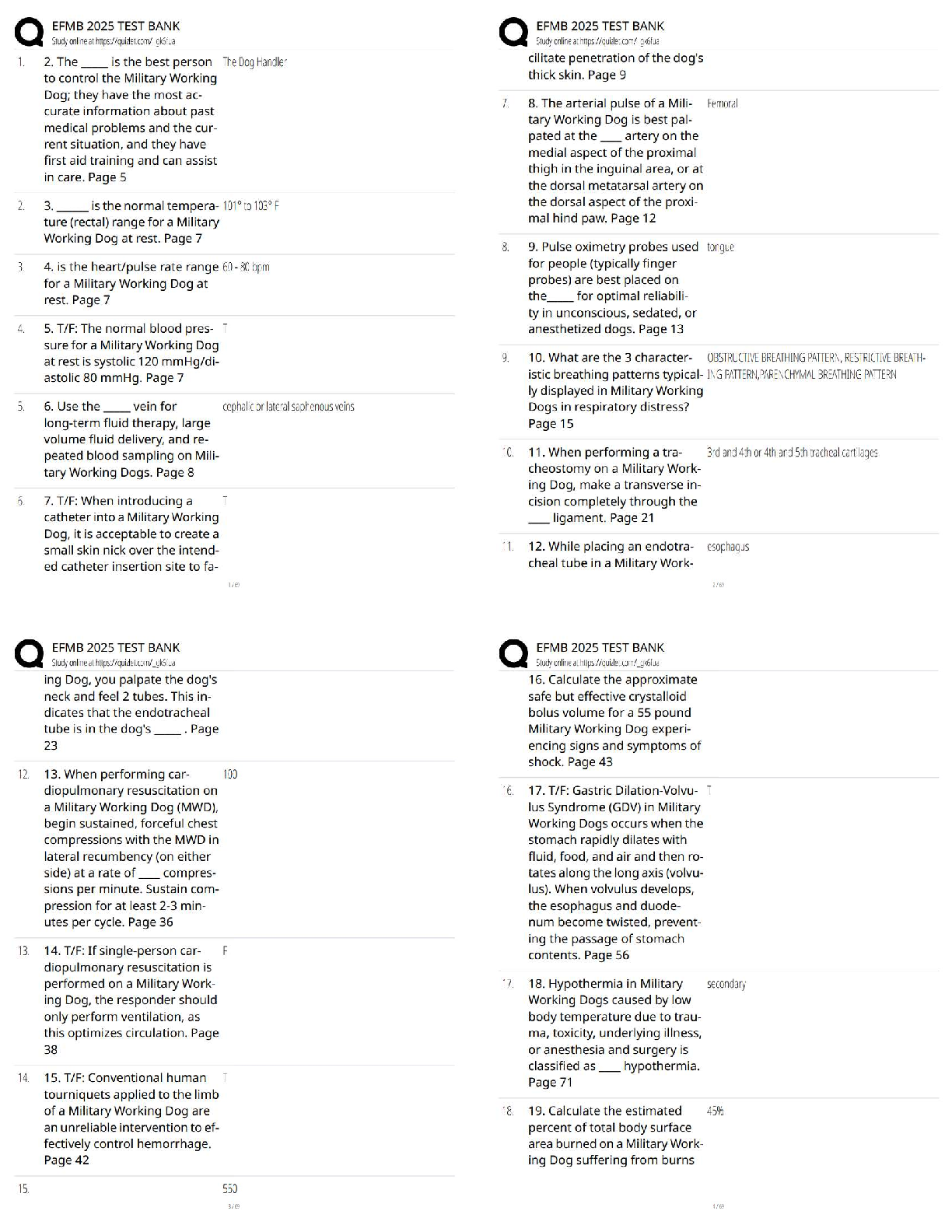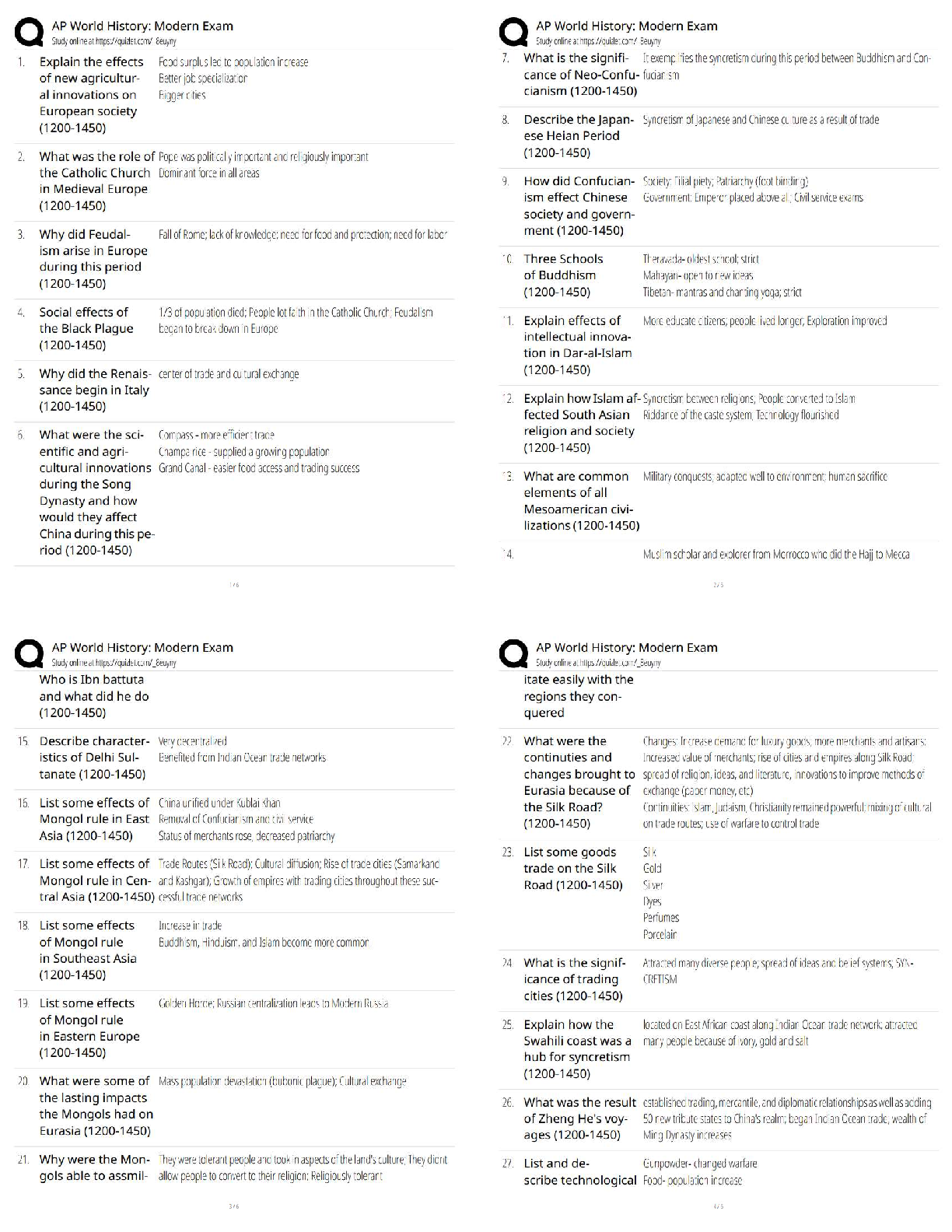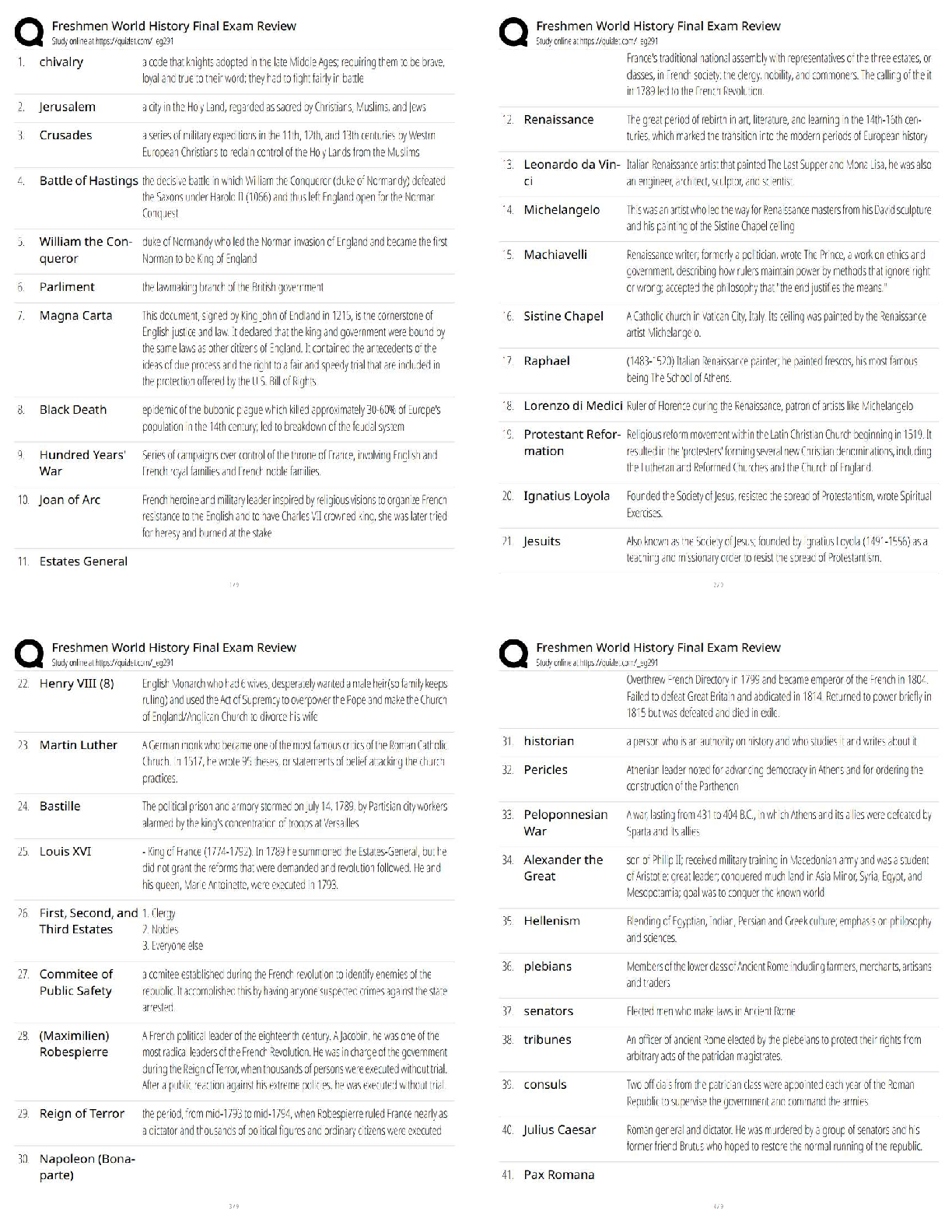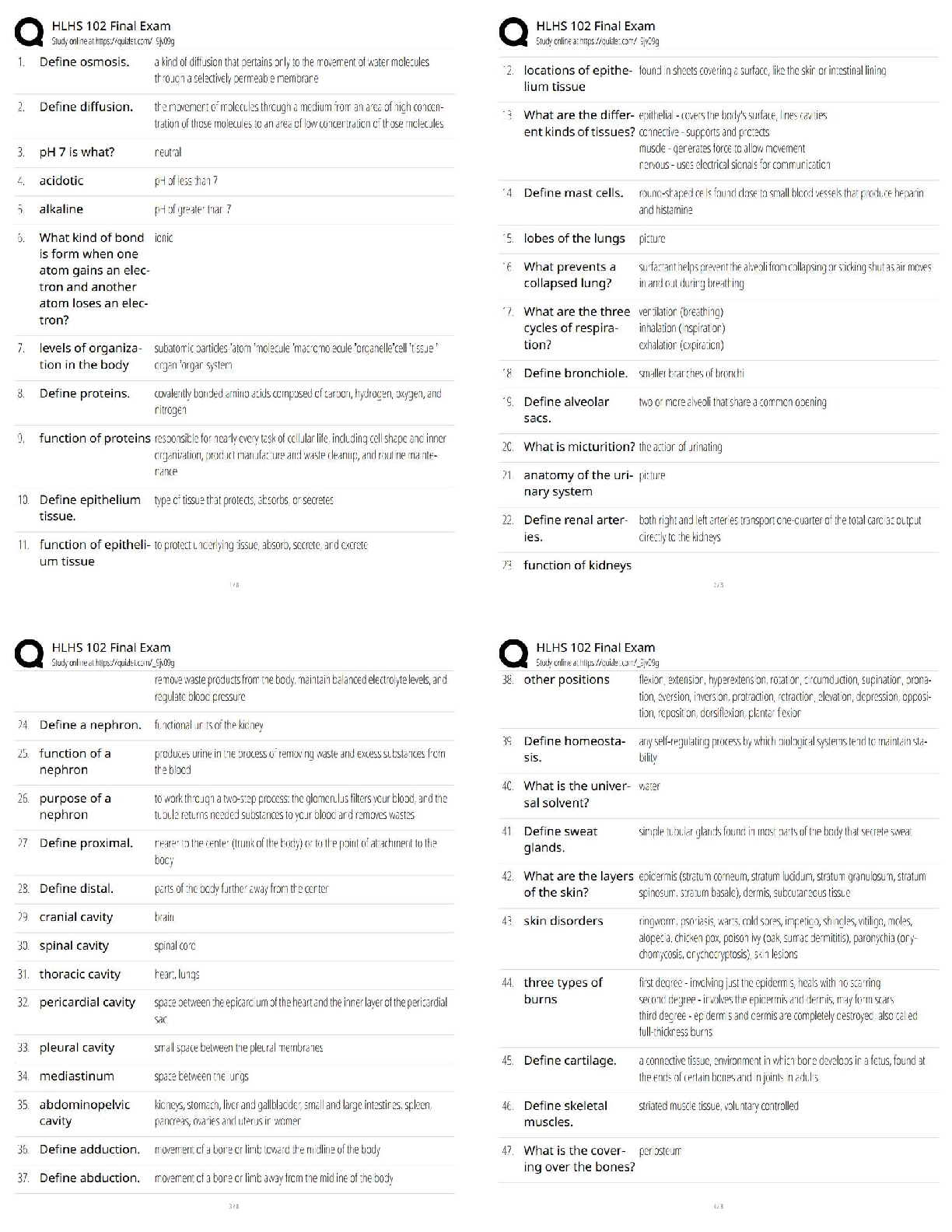ASWB Exam 2019 Practice Test (1-50) questions with accurate answers. Rated A+.
Document Content and Description Below
Social workers should refer clients to other professionals in all of the following instances EXCEPT when:
A.Professionals' specialized knowledge or expertise is needed to meet the clients' needs.
...
B.Social workers believe they are not being effective in addressing clients' concerns.
C.Professionals believe that other modalities of treatment may be more effective to resolve clients' issues.
D.Social workers are not making reasonable progress in addressing clients' problems. - ✔✔C
Social workers should refer clients to other professionals when the other professionals' specialized knowledge or expertise is needed to serve clients fully (A); when social workers believe that they are not being effective (B); and when social workers believe reasonable progress with clients is being made, but that additional service is required (D). The belief by other professionals that their services may be more effective (C) is not proper justification for a referral.
A social worker is working with a second grade child who is having trouble staying in her seat in the classroom. The social worker, in conjunction with the teacher, indicates that the immediate objective is that the child "will remain seated after being reminded to do so by the teacher while in the classroom." The social worker's supervisor, after reviewing the objective, would judge it to be:
A.Adequate as it addresses the target problem
B.Inadequate as it puts too much responsibility on the teacher
C.Adequate since the teacher was involved in the process
D.Inadequate as it lacks some elements of a measurable objective - ✔✔D
When social workers are creating intervention plans, it is essential that goals are written in observable and measurable terms. In this case vignette, the supervisor would judge it to be inadequate because it does not indicate the length of time that the child will be seated after being reminded or the time frame within which the objective is to be achieved—both critical elements of a measurable objective.
A social worker may limit a client's self-determination when the client's actions:
A.Pose a serious and imminent risk to self or others according to the social worker's judgment
B.Cause significant family dysfunction which threatens to impact on the psychological well-being of its members
C.Result in legal action such as arrests, fines, and/or civil penalties
D.Violate agency procedures and policies as established by the chief executive officer - ✔✔A
Social workers may only limit clients' rights to self-determination when, in the social workers' professional judgment, clients' actions or potential actions pose a serious, foreseeable, and imminent risk to themselves or others.
During assessment, partialization can be used by a social worker to assist a client with all of the following EXCEPT:
A.Recognizing the next action to take when intervening in a situation
B.Helping to clarify the specific cause(s) of a problem
C.Identifying issues that need immediate attention
D.Distinguishing areas that require further inquiry - ✔✔A
All of the response choices are examples of partialization. However, the question was related to its use during assessment. As it is related to the delivery of service, A is not an assessment task, but is instead required during planning or intervention.
According to Erikson, which of the following is seen as the last stage in psychosocial development?
A.Ego integrity versus despair
B.Trust versus mistrust
C.Intimacy versus isolation
D.Autonomy versus shame and doubt - ✔✔A
According to Erikson, older adults begin to slow down and contemplate their accomplishments. They assess whether they are satisfied with their life progression and become depressed or distraught if they are not. This stage is known as ego integrity versus despair. Trust versus mistrust occurs in the first year of life as infants learn whether the world is a place where their needs can be met. Intimacy versus isolation happens in early adulthood, and autonomy versus shame and doubt is a stage from ages 1 to 3 when children begin to explore the world on their own, learning independence.
Psychological abuse is MOST often detected by:
A.Confessions of perpetrators
B.Information supplied by collateral contacts
C.Behavioral characteristics of victims
D.Bruises or marks left by comorbid physical mistreatment - ✔✔C
The psychological consequences of abuse and neglect include isolation, fear, inability to trust, low self-esteem, anxiety, depression, and hopelessness. These difficulties can lead to relationship problems and the possibility of antisocial behavioral traits. Psychological abuse can, but does not always, happen at the same time (comorbid) with physical abuse. The most evident signs are the behavioral characteristics of victims.
A client shows a social worker a list of reasons why she should and should not leave her abusive husband. She says that she is preparing the list to see if the benefits are greater than the risks. The client is basing her decision on which of the following theories?
A.Systems
B.Functionalist
C.Harm reduction
D.Social exchange - ✔✔D
Social exchange theory is based on the idea of totaling potential benefits and losses to determine behavior. A client will leave a battering relationship when the alternative is seen as better than the current situation (rewards outweigh costs).
Which of the following is TRUE about human trafficking?
A.Human trafficking involves sexual exploitation.
B.Victims of human trafficking are poor females.
C.Human trafficking occurs in all countries except the United States.
D.Human trafficking is not the same as human smuggling. - ✔✔D
Human trafficking is not the same as human smuggling (D). "Trafficking" is based on exploitation and does not require movement across borders. "Smuggling" involves moving a person. Although human smuggling is very different from human trafficking, human smuggling can turn into trafficking if the smuggler uses force, fraud, or coercion to hold people against their will for the purposes of labor or sexual exploitation. Sex trafficking exists, but it is not the only type of human trafficking, making A incorrect. Forced labor is another type of human trafficking. Both involve exploitation of people. Human trafficking victims can be any age, race, gender, or nationality, and may come from any socioeconomic group. Therefore, B is incorrect. Human trafficking exists in every country, including the United States, so C has to be eliminated.
Role complementarity occurs when:
A.An individual takes on a new role that is appreciated by another
B.Two individuals act in an expected manner
C.There is confusion in the role definition of an individual
D.An individual successfully exits an existing role - ✔✔B
Role complementarity happens when there is a coordination of roles in a dyad or group (i.e., individuals act as expected by others). Role discomplementarity occurs when an individual acts differently than what is anticipated or is thought to be acceptable. Unclear expectations lead to role ambiguity and dysfunctional relationships or behavior. Thus, social workers aim to ensure that clients are aware of required actions and demands.
A social worker needs to contact a client who has not shown up for services in many weeks. He calls the number provided, only to get a household answering machine. The social worker leaves a simple message including his name, his agency name, and his contact information. The social worker's actions were:
A.Unethical because members of the household are now aware of the client's affiliation with the agency
B.Ethical since the client provided the phone number upon intake
C.Ethical as no details about the nature of the call were included in the message
D.Unethical because the reason for the call should have been fully disclosed - ✔✔A
Social workers should take precautions to ensure and maintain confidentiality of information transmitted to other parties through the use of email, fax machines, telephones and telephone answering machines, and other electronic or computer technology. In this case vignette, the social worker's actions were unethical because all household members and others who listen to the message will be aware of confidential information—that is, the client's affiliation with the agency (A).
Which is NOT a primary purpose of social work licensure?
A.Create parity with other helping professions to ensure that social workers receive comparable compensation
B.Identify standards for the safe professional practice of social work
C.Ensure social workers have the knowledge and skills to practice competently
D.Provide an avenue for investigating complaints and taking action to ensure continued safe and professional practice - ✔✔11.
A Social work licensure establishes the rules and regulations for professional practice (B), allows those who have met these standards and who follow these rules to engage in social work (C), and investigates complaints by members of the public in order to decide whether violations of the regulations have occurred and whether social workers should continue to practice (D).
Which of the following is NOT typically part of the sensorimotor stage of cognitive development?
A.Actions are imitative in nature.
B.Intentional actions begin to emerge.
C.Difference between past, present, and future is learned.
D.Primitive ability to manipulate objects is seen. - ✔✔C
The sensorimotor stage is first in Piaget's theory of cognitive development. It is characterized by primitive logic in manipulating objects (D), the onset of intentional actions (B), and imitative play (A). The ability to comprehend the difference between the past, present, and future (B) does not emerge, according to Piaget, until the preoperational stage, which begins at approximately age 2 and continues until about age 7.
What is the MOST significant difference between a formative and summative evaluation?
A.A summative evaluation is more scientifically rigorous than a formative evaluation.
B.A formative evaluation examines processes while a summative evaluation is focused on outcomes.
C.A summative evaluation examines processes while a formative evaluation is focused on outcomes.
D.A formative evaluation is more scientifically rigorous than a summative evaluation. - ✔✔B
A formative evaluation examines the processes that are occurring in an attempt to determine which are promoting and/or inhibiting successful outcomes. Information gathered from a formative evaluation can help alter program provisions to increase efficiency and/or effectiveness. A summative evaluation is focused on determining a program's effectiveness or outcomes. A summative evaluation provides valuable data at a program's completion to determine whether it should be continued, modified, or eliminated.
When a social worker receives a subpoena, he or she must:
A.Send the client his or her records so the client can respond to the subpoena
B.Claim privilege and not release any information until court-ordered to do so
C.Send the records immediately to the court in order to avoid being sanctioned
D.Submit a written summary of services rendered to the court in lieu of sending the records - ✔✔B
A subpoena and court order are not the same. When receiving a subpoena, a social worker should respond and claim privilege, but should not turn over records unless the court issues a subsequent order to do so (B). When a social worker gets a court order, he or she should try to limit its scope or request that the records be sealed.
A client tells a social worker that he feels "alone" and does not think that anyone else is having the same problems that he is experiencing. In order to assist the client, it is BEST that the social worker:
A.Ask the client to explain further what he means by feeling "alone"
B.Determine whether the client is at risk for suicide and in need of hospitalization
C.Refer the client to counseling for depression
D.State that many people have encountered similar difficulties and that the social worker is there to help - ✔✔D
The social worker should intervene to let the client know that he is not alone as the social worker is available to assist (D). The client may feel isolated or alone because he has never met anyone with similar problems. It is important to acknowledge that each client's situation is unique, but a social worker must also instill hope by making it clear that others have made changes or overcome similar challenges. Based on the client's use of the word "alone," there is no indication that he is at risk, so a risk assessment is not warranted (B). Exploring the client's feelings further (A) and receiving counseling (C) may be needed, but the case vignette does not provide enough information to indicate that the client is clinically depressed as opposed to having a typical response encountered with many clients who are experiencing a wide variety of problems.
A client who is going through a bitter divorce tells a social worker that she "does not know how this will ever turn out well." The social worker, who is divorced, remembers when she also felt that way. To appropriately assist the client, the social worker should
[Show More]
Last updated: 3 years ago
Preview 1 out of 29 pages

